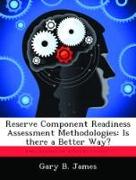Reserve Component Readiness Assessment Methodologies: Is there a Better Way?
BücherAngebote / Angebote:
Reserve Component unit readiness is important because the Army cannot operate in any spectrum of conflict without mobilizing reserve forces. Major portions of the Army's support structure reside in the reserves. The current Unit Status Report does not adequately assess unit training readiness using objective data, but relies on commanders', subjectivity. This monograph serves to analyze the current readiness reporting system, identify shortcomings in the system, and recommend solutions. Therefore the study is significant to identifying ways to improve readiness assessment reporting, thus streamlining the mobilization process. Over the last thirty years the Army has gotten smaller, and transferred many critical capabilities in the Reserve Components. Over half of the Total Army's force structure exist in the Reserve Components, including sixty percent of the combat forces, fifty-four percent of combat support, and approximately sixty-eight percent of combat service support forces Certain capabilities, such as civil affairs, reside almost exclusively in the reserves. Therefore, the Reserve Components must be mobilized, at some level, to support Army deployments. The purpose of this monograph is to evaluate the applicability of the current Reserve Component unit readiness assessment process, and determine if other methods of readiness assessment are more effective. The study uses historical references to lay the groundwork for understanding the current assessment system. However, it primarily addresses current readiness assessment methodologies (grounded in regulation and doctrine) as prescribed by Unit Status Reporting (USR) procedures, and Forces Command pre-mobilization training requirements, as outlined in FORSCOM Regulations. Since readiness and mobilization are symbiotic processes, doctrinal concepts from the FORSCOM Mobilization and Deployment Planning System (FORMDEPS) series of regulations will be reviewed when appropriate. The system will be analyzed to dete
Folgt in ca. 15 Arbeitstagen





